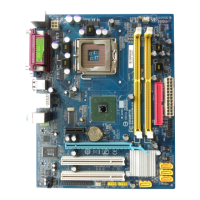35
Please refer to section 3-7-1
Onboard Device Function
Please refer to section 3-7-2
Onboard Super IO Function
Please refer to section 3-7-3
PWR Status after PWR Failure
The settings are: Former Status; Always On; Always Off.
Init Display First
This item allows you to decide to whether activate PCI Slot or PCI Express first. The
settings are: PCI Slot, PCI Express.
3-7-1 Onboard IDE Function
Phoenix – AwardBIOS CMOS Setup Utility
Onboard IDE Function
Item Help
On-Chip Primary PCI IDE Enabled
On-Chip Secondary PCI IDE Enabled
IDE Primary Master PIO Auto
IDE Primary Slave PIO Auto
IDE Secondary Master PIO Auto
IDE Secondary Slave PIO Auto
IDE Primary Master UDMA Auto
IDE Primary Slave UDMA Auto
IDE Secondary Master UDMA Auto
IDE Secondary Slave UDMA Auto
IDE DMA Transfer Access Enabled
IDE HDD Block Mode Enabled
Delay for HDD (Secs) 0
*** On-Chip Serial ATA Auto
*PATA IDE Mode Disabled
SATA Port P1,P3 is Secondary
*SATA Port Speed Settings Disabled
Menu Level >>
↑↓→←
Move Enter:Select +/-/PU/PD:Value F10:Save ESC:Exit F1:General Help
F5:Previous Values F6:Optimized Defaults F7:Standard Defaults
IDE DMA transfer access
The integrated peripheral controller contains an IDE interface with support for one IDE channels.
Select Enabled to activate each channel separately. The settings are: Enabled and Disabled.
Primary /Secondary Master/Slave PIO
The two IDE PIO (Programmed Input/Output) fields let you set a PIO mode (0-2) for each of the two
IDE devices that the onboard IDE interface supports. Modes 0 through 2 provide successively
increased performance. In Auto mode, the system automatically determines the best mode for each
device. The settings are: Auto, Mode 0, Mode 1, Mode 2, Mode 3, Mode 4.
Primary /Secondary Master/Slave UDMA
Ultra DMA/33 implementation is possible only if your IDE hard drive supports it and the
operating environment includes a DMA driver (Windows 95 OSR2 or a third-party IDE bus

